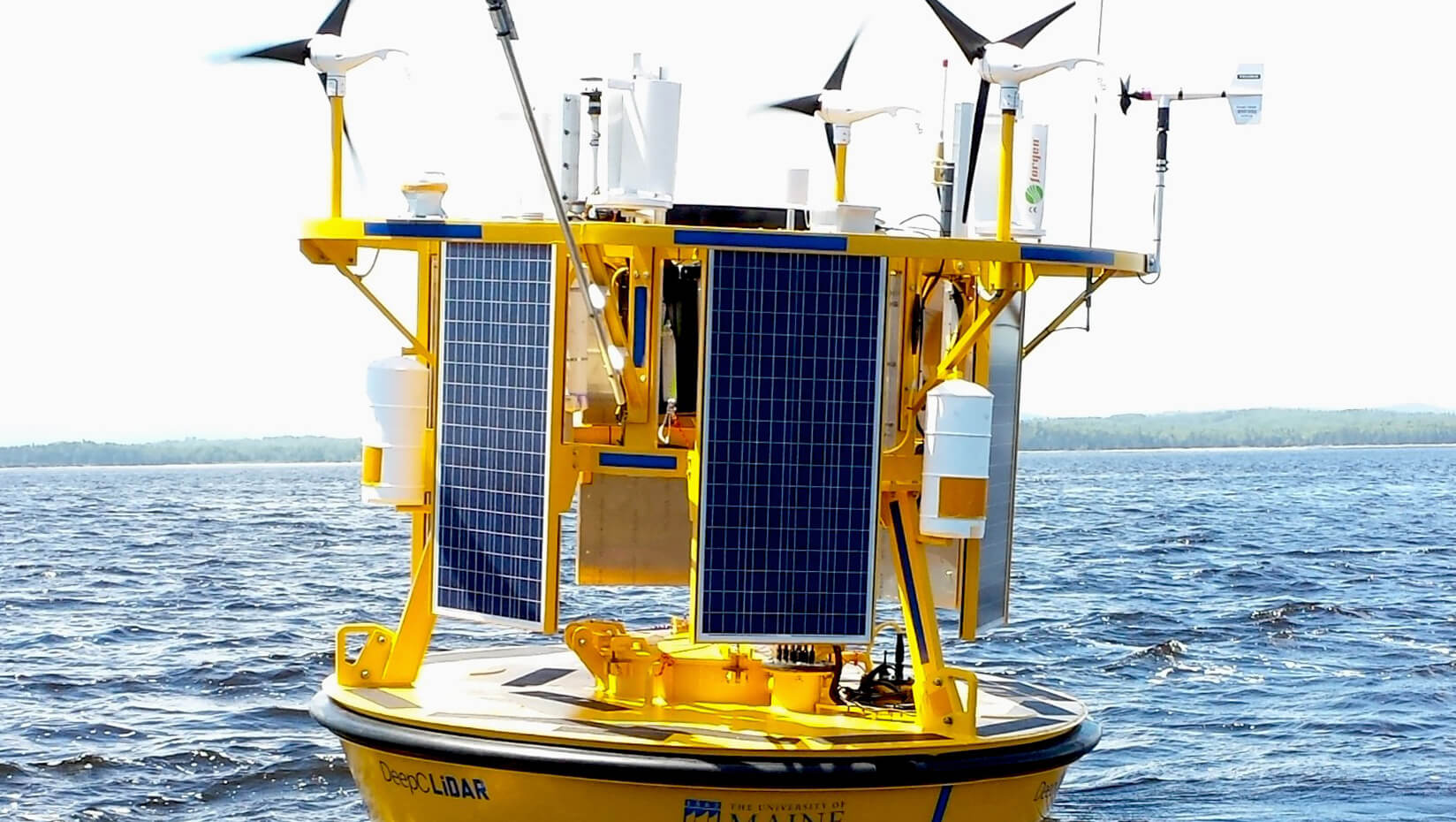
DeepCLiDAR completes predeployment validation, available for commercial lease or purchase
Editor’s note: Story updated Oct. 27.
DeepCLiDAR, a floating light detection and ranging (LiDAR) system developed by the University of Maine Advanced Structures and Composites Center and the Physical Oceanography Group (PhOG) of the School of Marine Sciences, has successfully completed a new deployment performance test 12 miles off the Maine coast in 65 meters of water. AWS Truepower validated DeepCLiDAR’s data recovery and measurement accuracy against Carbon Trust’s industry-standard performance criteria. With successful third-party validation complete, DeepCLiDAR is now available for commercial lease or purchase.
DeepCLiDAR will help accelerate the development of the U.S. offshore wind industry by providing high-quality, low-cost offshore wind resource data, metocean monitoring and ecological characterization capabilities in remote marine environments.
The recent five-month test concluded a robust, three-phase validation program that sequentially vetted the DeepCLiDAR’s performance onshore, nearshore and offshore. The validation campaign was jointly developed by AWS Truepower and UMaine to characterize the floating LiDAR’s measurements in the absence of an offshore meteorological tower. The basis for the system’s evaluation and acceptance were the Key Performance Indicators and Acceptance Criteria defined by the Carbon Trust.
“This technology will advance the U.S. and international offshore wind industry by providing a cost-effective method to assess the wind resource in areas traditionally off-limits to offshore wind developers,” said Habib Dagher, executive director of the UMaine Advanced Structures and Composites Center. “The buoy is the first validated for use in the northeastern U.S. and will support the first floating wind farm in the U.S.”
“The DeepCLiDAR buoy system and electronics are based on ocean observing buoy technology developed and tested by UMaine’s Physical Oceanography Group over the past 20 years in the Gulf of Maine and abroad,” said Anthony Viselli, manager of Offshore Model Testing and Structural Design at the UMaine Composites Center.
DeepCLiDAR, which can be deployed in virtually any depth, is fully self-powered through its solar panels and wind turbines and has operated autonomously for more than six months 12 miles off the Maine coast.
DeepCLiDAR houses a modified WINDCUBE® Offshore LiDAR Remote Sensor, which has been adapted to a dynamic marine environment to measure wind conditions using laser technology up to 200 meters above the ocean surface.
Both the U.S. Department of Energy and the Maine Technology Institute (MTI) provided funding to support the R&D leading to the successful validation of the DeepCLiDAR buoy, including this critical third-party validation of the technology. MTI has also provided funding for commercialization planning to bring this new technology to the offshore wind industry.
“MTI has been pleased to provide funding to UMaine that has enabled the successful offshore validation of the DeepCLiDAR buoy,” said MTI President Brian Whitney. “The third-party validation demonstrates that the buoy can conduct accurate wind resource assessments in the harsh northeast Atlantic and reveals that DeepCLiDAR is well-positioned to capitalize on the enormous potential of the worldwide offshore wind market.”
AWS Truepower, the third party that validated DeepCLiDAR, is one of the world’s leading providers of renewable energy solutions to developers, investors, utilities and governments.
“DeepCLiDAR performed well during its validation, exceeding the Carbon Trust’s acceptance criteria for wind speed and direction measurements,” said AWS Truepower principal engineer Matthew Filippelli. “In spite of the inherent challenges of validating floating LiDAR in the U.S. — notably, the absence of an offshore meteorological tower — the DeepCLiDAR has demonstrated a precommercial level of technical maturity. AWST considers this system valid for use in an offshore wind resource and design condition assessment campaign in similar metocean conditions.”
DeepCLiDAR was first deployed and validated in 2013 alongside UMaine’s VolturnUS 1:8 floating offshore wind turbine during its 18-month deployment off the coast of Castine, Maine. VolturnUS 1:8 was the first grid-connected offshore wind turbine in the U.S. and the first in the world to use a concrete hull and composite material tower.
Contact: Anthony Viselli, anthony.viselli@maine.edu, 207.581.2828
UMaine Advanced Structures and Composites Center
The UMaine Advanced Structures and Composites Center conducts research, and provides education and economic development encompassing material sciences, manufacturing and engineering of composites and structures. The center recently expanded to test full-scale wind blades up to 70 meters as well as offshore model testing in its Alfond W2 Ocean Engineering Lab, a very unique wind-wave basin. The center has gained national and international reputation from major research and development projects such as the VolturnUS 1:8, the first grid-connected floating offshore wind turbine in the U.S. and the first in the world made out of concrete and composite materials, the inflatable composite arch bridges Bridge-in-a-Backpack technology now approved in the AASHTO Code, the first Modular Ballistic Protection System (MBPS) approved by the U.S. Army to protect troops in tents from blast and ballistic threats, development of coated wood technology for blast and hurricane resistant wood buildings, and the longest carbon-fiber composite vessel built for the U.S. Navy.
Maine Technology Institute
MTI is a publicly financed, private nonprofit organization created by the Legislature in 1999 to stimulate research and development activity leading to the commercialization of new products, processes and services in the state’s seven targeted technology sectors. MTI programs are either loans, equity investments, or grants designed to enhance the competitive position of those sectors and increase the likelihood that one or more of these sectors will support clusters of industrial activity and create quality jobs across Maine.
UMaine Physical Oceanography Group
UMaine’s Physical Oceanography Group develops and operates real-time ocean observing systems. It operates the Gulf of Maine Observatory as part of the Northeast Regional Association of Coastal and Ocean Observing Systems and the real-time buoy array of the Caribbean Integrated Ocean Observing System.
AWS Truepower
AWS Truepower is a leading global consulting firm with over 30 years of experience in energy and resource solutions, engineering and measurement services, software, and data platforms. It has worked on the design and assessment of over 120,000 MW of renewable energy projects, both on land and offshore, in over 80 countries.
